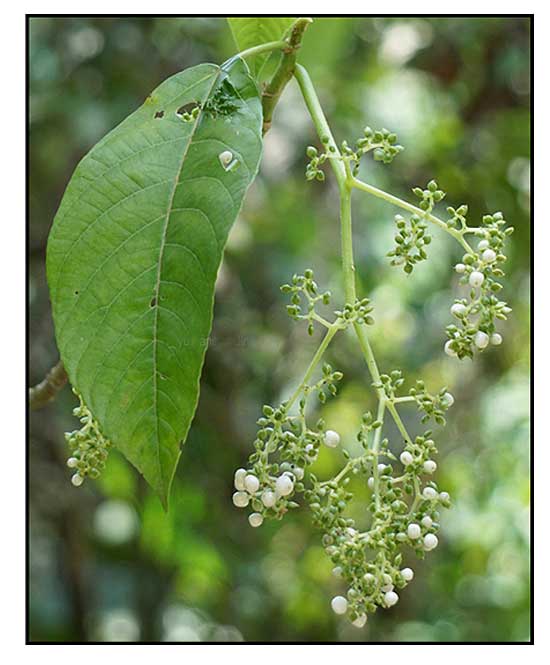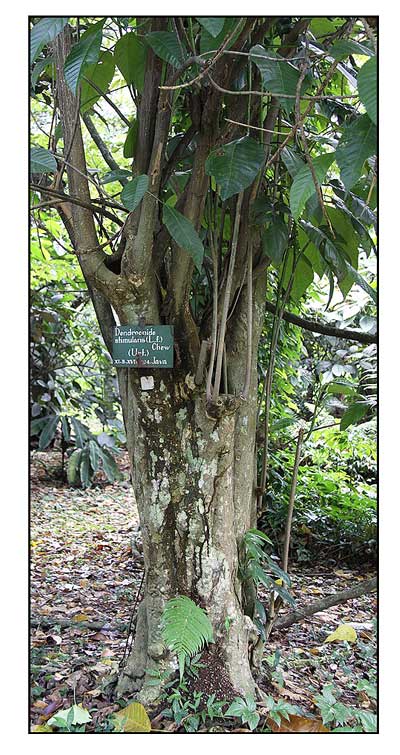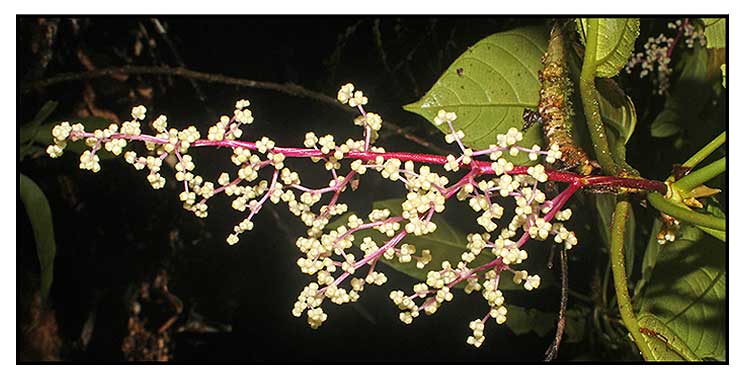
Family • Urticaceae
Stinging tree
Dendrocnide stimulans (L.f..) Chew
WOOD NETTLE
Hai nan huo shu ma
| Scientific names | Common names |
| Dendrocnide costata Miq. | Elephant tree nettle (Engl.) |
| Dendrocnide stenophylla (Quisumb.) Chew. | Malay tree nettle (Engl.) |
| Dendrocnide stimulans (L.f.) Chew. | Nettle tree (Engl.) |
| Laportea annamica Gagnep. | Stinger (Australia) |
| Laportea brunnea Merr. | Stinging tree (Australia) |
| Laportea costata (Miq.) Miq. | Wood nettle (Engl.) |
| Laportea gracilipes Elmer | |
| Laportea hainanensis Merr. & F.P.Metcalf | |
| Laportea lanaensis C.B.Rob. | |
| Laportea sinuata Blume ex Wedd. | |
| Laportea stenophylla Quisumb. | |
| Laportea stimulans (L.f.) Miq. | |
| Laportea stimulans var. bovina Hochr. | |
| Laportea stimulans var. costata (Miq.) Miq. | |
| Laportea thorelii Gagnep.. | |
| Urera stimulans (L.f.) Wedd. | |
| Urtica stimulans L.f. | |
| Urtica stimulans f. obtusa Blume | |
| Urticastrum costatum (Miq.) Kuntze | |
| Urticastrum sinuatum (Blume ex Wedd.) Kuntze | |
| Urticastrum stimulans (L.f.) Kuntze | |
| No local name found. | |
| Dendrocnide stimulans is an accepted species. KEW: Plants of the World Online | |
| Note: "Stinging tree" as English name is shared by many species in this nettle family. | |
| Other vernacular names |
| CHINA: Hai nan huo shu ma. |
| INDONESIA: Jalatong pulus (Sundanese), Kemaduh sapi (Javanese), Jelatang kayu (Sumatra). |
| MALAYSIA: Jelatang gajah, Jelatang api, Daun gatal. |
| THAILAND: Tamyae chaang (Central), Saam kaeo (Peninsular), Haan duea (northern), Ai khu na (Karen), E ko poe, Han sa, Sam kaeo. |
| VIETNAM: Man nam, Han tim. |
| OTHERS: Pulus marlela, Daun pulus, Maduh. |
October 2025
![]()
 |
| PHOTOS / ILLUSTRATIONS |
| OTHER IMAGE SOURCE: Dendrocnide stimulans / © Ganjar Cahyadi / Some rights reserved / CC BY-NC / Image modified / Click on image or link to go to source page / iNaturalist |
| OTHER IMAGE SOURCE: Dendrocnide stimulans / © Yusran E Ritonga / Some rights reserved / CC BY-NC / Image modified / Click on image or link to go to source page / iNaturalist |
| IMAGE SOURCE: Urticaceae : Dendrocnide stimulans / Staminate inflorescence / Copyright © 2024 by Kean Roc Mazo (contact: pieter.pelser@canterbury.ac.nz) [ref. DOL428223] / Non-Commercial Use / Image modified / Click on image or link to go to source page / Phytoimages.siu.edu |
Additional
Sources and Suggested Readings |
• |
DOI: It is not uncommon for links on studies/sources to change. Copying and pasting the information on the search window or using the DOI (if available) will often redirect to the new link page. (Citing and Using a (DOI) Digital Object Identifier) |
| List of Understudied Philippine Medicinal Plants |
| New plant names needed The compilation now numbers over 1,730 medicinal plants. While I believe there are hundreds more that can be added to the collection, they are becoming more difficult to find. If you have a plant to suggest for inclusion, native or introduced, please email the info: scientific name (most helpful), local plant name (if known), any known folkloric medicinal use, and, if possible, a photo. Your help will be greatly appreciated. |
• |
 |


 Distribution
Distribution
